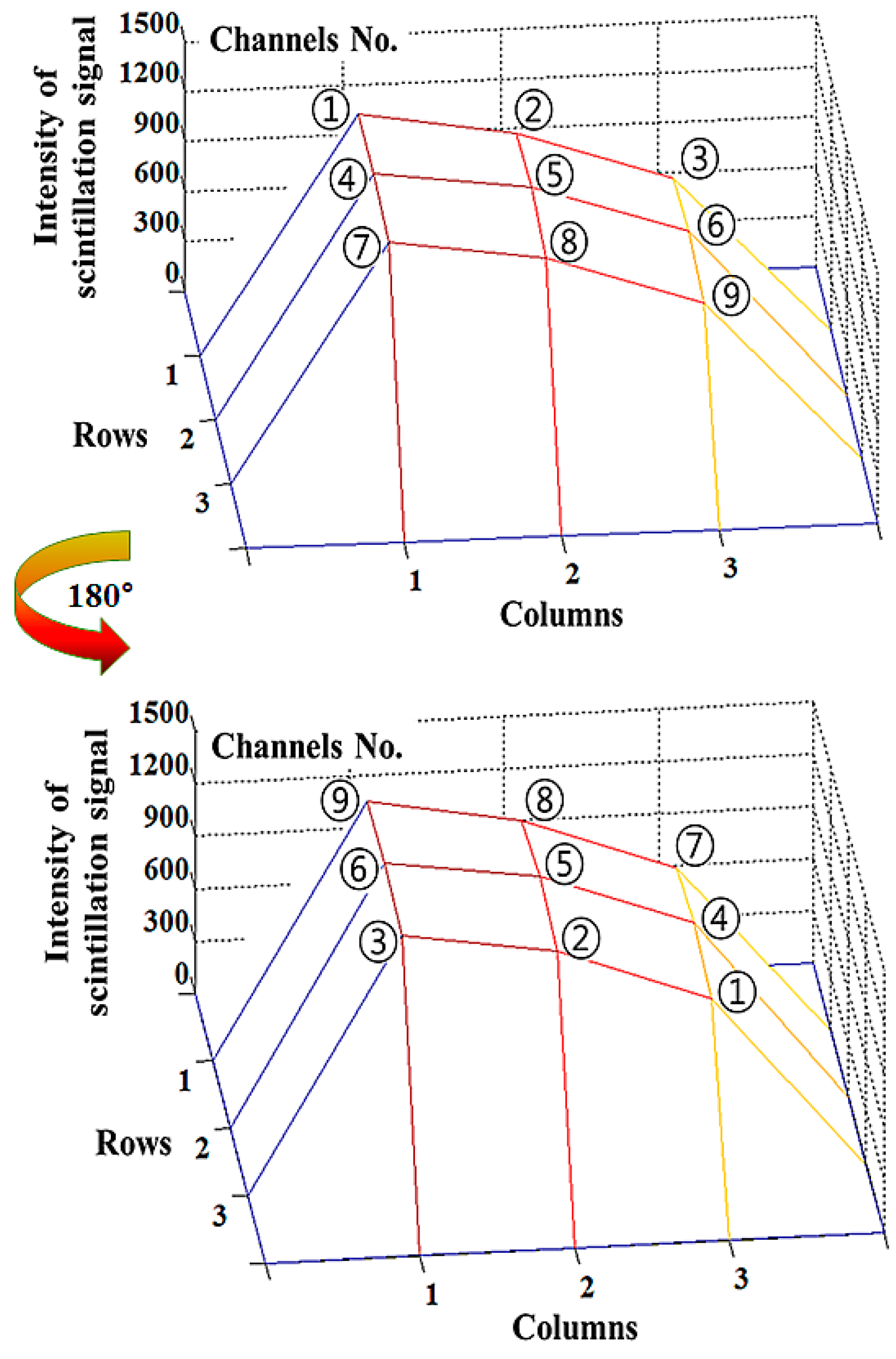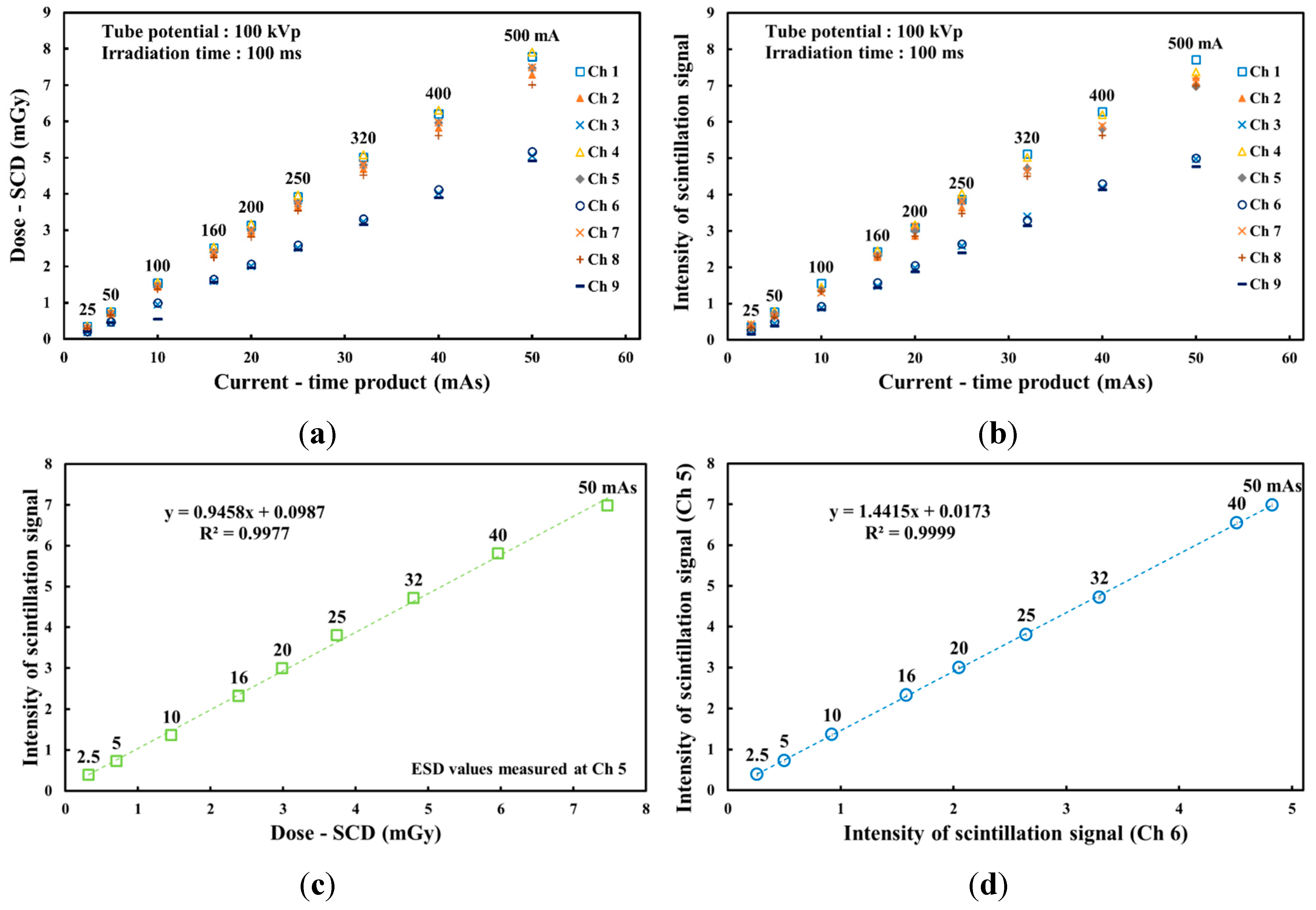Performance Evaluation of a Multichannel All-In-One Phantom Dosimeter for Dose Measurement of Diagnostic X-ray Beam
Abstract
:1. Introduction
2. Materials and Instruments
2.1. Fabrication of Nine Sensing Probes

2.2. Multichannel All-In-One Phantom Dosimeter System for Measuring Planar Dose Distribution of X-ray Beam

3. Experimental Results
3.1. Measurement of Planar Dose Distribution

3.2. Performance Evaluation of a Multichannel All-In-One Phantom Dosimeter According to the Tube Potential


3.3. Performance Evaluation of a Multichannel All-In-One Phantom Dosimeter as a Function of the Current-Time Product


4. Discussion and Conclusions
Acknowledgments
Author Contributions
Conflicts of Interest
References
- Andria, G.; Nisio, A.D.; Lanzolla, A.M.L.; Guglielmi, G.; Terlizzi, R. Dose Optimization in Chest Radiography: System and Model Characterization via Experimental Investigation. IEEE Trans. Instrum. Meas. 2014, 63, 1163–1170. [Google Scholar] [CrossRef]
- Gislason-Lee, A.J.; McMillan, C.; Cowen, A.R.; Davies, A.G. Dose optimization in cardiac X-ray imaging. Med. Phys. 2013, 40. [Google Scholar] [CrossRef] [PubMed]
- Yoo, W.J.; Jeon, D.J.; Seo, J.K.; Shin, S.H.; Han, K.-T.; Youn, W.S.; Cho, S.; Lee, B. Development of a scintillating fiber-optic dosimeter for measuring the entrance surface dose in diagnostic radiology. Radiat. Meas. 2013, 48, 29–34. [Google Scholar] [CrossRef]
- Soldt, R.T.M.V.; Zweers, D.; Berge, L.V.D.; Geleijns, J.; Jansen, J.T.M.; Zoetelef, J. Survey of posteroanterior chest radiography in the Netherlands: Patient dose and image quality. Brit. J. Radiol. 2014, 76, 398–405. [Google Scholar] [CrossRef] [PubMed]
- Tsapaki, V.; Tsalafoutas, I.A.; Chinofoti, I.; Karageorgi, A.; Carinou, E.; Kamenopoulou, V.; Yakoumakis, E.N.; Koulentianos, E.D. Radiation doses to patients undergoing standard radiographic examinations: A comparison between two methods. Brit. J. Radiol. 2007, 80, 107–112. [Google Scholar] [CrossRef] [PubMed]
- Conway, B.J.; Butler, P.F.; Duff, J.E.; Fewell, T.R.; Gross, R.E.; Jennings, R.J.; Koustenis, G.H.; McCrohan, J.L.; Rueter, F.G.; Showalter, C.K. Beam quality independent attenuation phantom for estimating patient exposure from x-ray automatic exposure controlled chest examinations. Med. Phys. 1984, 11, 827–832. [Google Scholar] [CrossRef] [PubMed]
- Yoo, W.J.; Shin, S.H.; Jeon, D.J.; Hong, S.; Sim, H.I.; Kim, S.G.; Jang, K.W.; Cho, S.; Youn, W.S.; Lee, B. Measurement of entrance surface dose on an anthropomorphic thorax phantom using a miniature fiber-optic dosimeter. Sensors 2014, 14, 6305–6316. [Google Scholar] [CrossRef] [PubMed]
- Yoo, W.J.; Jeon, D.J.; Seo, J.K.; Shin, S.H.; Han, K-T.; Hong, S.; Kim, S.G.; Cho, S.; Lee, B. Development of a fiber-optic dosimeter based on modified direct measurement for real-time dosimetry during radiation diagnosis. Meas. Sci. Technol. 2013, 24. [Google Scholar] [CrossRef]
- Hyer, D.E.; Fisher, R.F.; Hintenlang, D.E. Characterization of a water-equivalent fiber-optic coupled dosimeter for use in diagnostic radiology. Med. Phys. 2009, 36, 1711–1716. [Google Scholar] [CrossRef] [PubMed]
- Jones, A.K.; Hintenlang, D. Potential clinical utility of a fibre optic-coupled dosemeter for dose measurements in diagnostic radiology. Rad. Prot. Dosim. 2008, 132, 80–87. [Google Scholar] [CrossRef] [PubMed]
- Benevides, L.A.; Huston, A.L.; Justus, B.L.; Falkenstein, P.; Brateman, L.F.; Hintenlang, D.E. Characterization of a fiber-optic-coupled radioluminescent detector for application in the mammography energy range. Med. Phys. 2007, 34, 2220–2227. [Google Scholar] [CrossRef] [PubMed]
- Ardran, G.M.; Crooks, H.E. Checking diagnostic X-ray beam quality. Brit. J. Radiol. 2014, 41, 193–198. [Google Scholar] [CrossRef] [PubMed]
- Chu, R.Y.L.; Fisher, J.; Archer, B.R.; Conway, B.J.; Goodsitt, M.M.; Glaze, S.; Gray, J.E.; Strauss, K.J. Standardized Methods for Measuring Diagnostic X-ray Exposures; AAPM Report 31; American Institute of Physics: New York, NY, USA, 1990. [Google Scholar]
© 2015 by the authors; licensee MDPI, Basel, Switzerland. This article is an open access article distributed under the terms and conditions of the Creative Commons Attribution license (http://creativecommons.org/licenses/by/4.0/).
Share and Cite
Jeon, H.; Yoo, W.J.; Shin, S.H.; Kwon, G.; Kim, M.; Kim, H.J.; Song, Y.B.; Jang, K.W.; Youn, W.S.; Lee, B. Performance Evaluation of a Multichannel All-In-One Phantom Dosimeter for Dose Measurement of Diagnostic X-ray Beam. Sensors 2015, 15, 28490-28501. https://doi.org/10.3390/s151128490
Jeon H, Yoo WJ, Shin SH, Kwon G, Kim M, Kim HJ, Song YB, Jang KW, Youn WS, Lee B. Performance Evaluation of a Multichannel All-In-One Phantom Dosimeter for Dose Measurement of Diagnostic X-ray Beam. Sensors. 2015; 15(11):28490-28501. https://doi.org/10.3390/s151128490
Chicago/Turabian StyleJeon, Hyesu, Wook Jae Yoo, Sang Hun Shin, Guwon Kwon, Mingeon Kim, Hye Jin Kim, Young Beom Song, Kyoung Won Jang, Won Sik Youn, and Bongsoo Lee. 2015. "Performance Evaluation of a Multichannel All-In-One Phantom Dosimeter for Dose Measurement of Diagnostic X-ray Beam" Sensors 15, no. 11: 28490-28501. https://doi.org/10.3390/s151128490
APA StyleJeon, H., Yoo, W. J., Shin, S. H., Kwon, G., Kim, M., Kim, H. J., Song, Y. B., Jang, K. W., Youn, W. S., & Lee, B. (2015). Performance Evaluation of a Multichannel All-In-One Phantom Dosimeter for Dose Measurement of Diagnostic X-ray Beam. Sensors, 15(11), 28490-28501. https://doi.org/10.3390/s151128490





